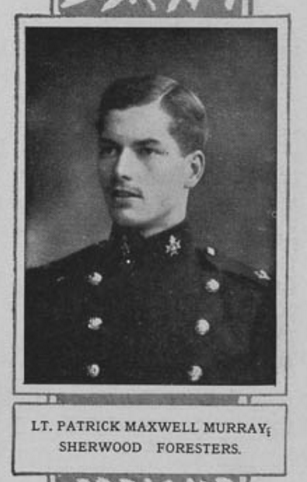
Patrick Maxwell Murray was the first Melton man to
lose their life in the Great War.
Patrick Maxwell Murray was born on 24th April 1890 in North Kensington, London. He was educated at Gisburne House in Watford, before attending Repton School. During his time at Repton, Patrick was a member of the school shooting team from 1906 to 1908. It was during this time that the team took part in, and won the rapid firing prize at Bisley in 1906.
Between 1908 and 1909, Patrick attended the Royal Military Academy, Woolwich, before receiving a commission into the Nottingham and Derbyshire Regiment – the Sherwood Foresters. In 1911, he was made assistant adjutant of the 2nd Sherwood Foresters and was further promoted to Lieutenant in August that year. During his assistant adjutancy, the battalion’s shooting improved and he was to lead them to success in several competitions. Patrick also obtained the musketry certificate and became qualified to use the Maxim Machine Gun.
When the war started, the 2nd Sherwood Foresters prepared to be mobilised and regimental reservists began arriving at their depot in Sheffield. On the 7th August, they received orders sending them to Edinburgh the next day. A week later, they were ordered to move once more: this time to make camp on Midsummer Common in Cambridge where they stayed from 14th August to 7th September.
On the 8th September, Patrick and the battalion were mobilised to France and, having marched to Newmarket, entrained for Southampton, where they boarded the SS Georgian for the short trip to St Nazaire. In France, they were held up outside the harbour for a day and landing did not begin until 23:00 on the 11th September. Patrick and the battalion continued to disembark from the SS Georgian throughout the morning of the 12th.
The battalion war diary says:
“Continued disembarkation which had been proceeding during the night. No shore cranes were available and all transport etc had to be put ashore by the ship’s derricks, a slow process. Battalion left St Nazaire by train at 1:45pm but had to leave behind certain carts and wagons not yet landed.”
The 2nd Sherwood Forresters travelled by train to Coulommers where they billeted overnight and, the following afternoon, started to march to the front line, some seventy miles away. They reached Dhuizel, near the River Aisne, after dark on the 18th and went directly into billets. They had little time to rest however, being called to stand to arms due to hearing heavy rifle fire. At 03:00, they were on the road again, heading for Troyon, a few miles north of the River Aisne. On arrival, the battalion went into the reserve trenches, before moving that evening into the forward trenches.
The war diary entry from Sunday 20th September says:
“In reserve north of the village (Troyon). There was an alarm and the enemy were seen to have taken trenches to the right of the British line on the ridge at the head of the Troyon valley, the most vital point in the line of defence. The Battalion moved out to retake the trenches. A German column was seen to be marching off prisoners. A & C Companies who were in bivouac nearest the trench moved out at once under Capts Popham and Parkinson, Major Leveson-Gower joined them at the head of the valley. Their advance was met by a very heavy machine gun fire from the front and left flank which caused heavy casualties, the ground devoid of cover and very cramped. The advance was checked until the other two companies, which were close up, reinforced the line and then a general advance was made with great dash and in spite of heavy losses the trenches were retaken.
The Battalion then prepared to hold the trenches just as the men had entered them. It was impossible to sort the companies out and “dugout” and there were no communications. For this reason, it was not possible to call a roll as to arrive at the exact number of casualties for the day. In Officers these amounted to 4 killed and eight wounded. Other ranks about 180 of which some 40 were killed.
This was a most important action as the safety of the British right and the bridge over the River Aisne at Bourg depended on the maintenance of the trenches. All ranks behaved splendidly.”
One of the officers killed that day was Patrick Maxwell Murray. He was held in high esteem by his fellow officers. One wrote:
“He did so well on that dreadful Sunday, perfectly cool and collected the whole time.”
His Colonel went further and said:
"His death was in every way worthy of the man he had proved himself to be, and his life was freely given in the noblest of causes. After a very dashing advance in which he was one of the first to gain the trenches from which the enemy had been driven by another British corps, he was there killed instantaneously while encouraging his men and watching every turn of the fight at his own peril."
Patrick was buried on the battlefield, the location of which was lost during the ensuing years of the war. He is remembered on the La Ferte-Sous-Jouarre Memorial in France. He is also remembered on the Melton and Repton School Memorials.
